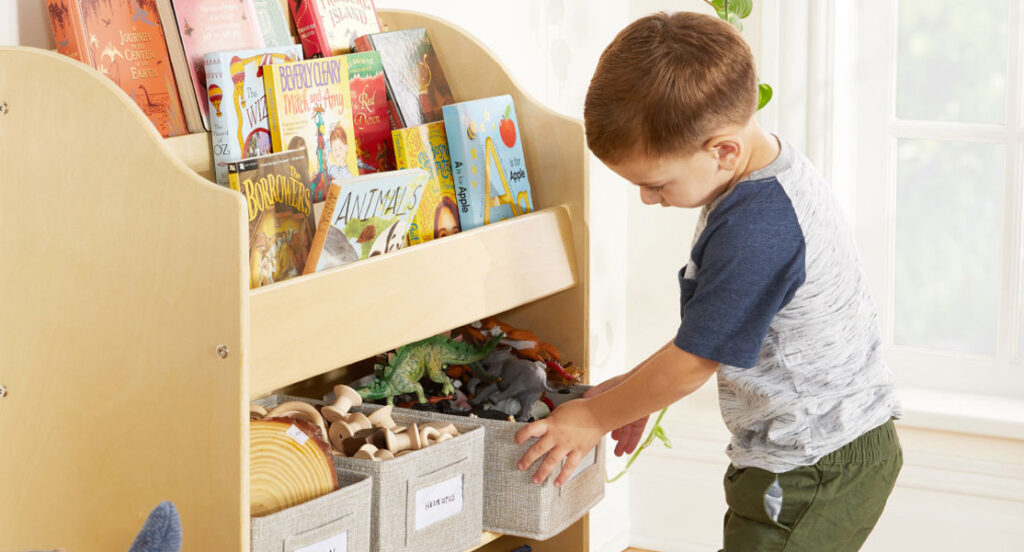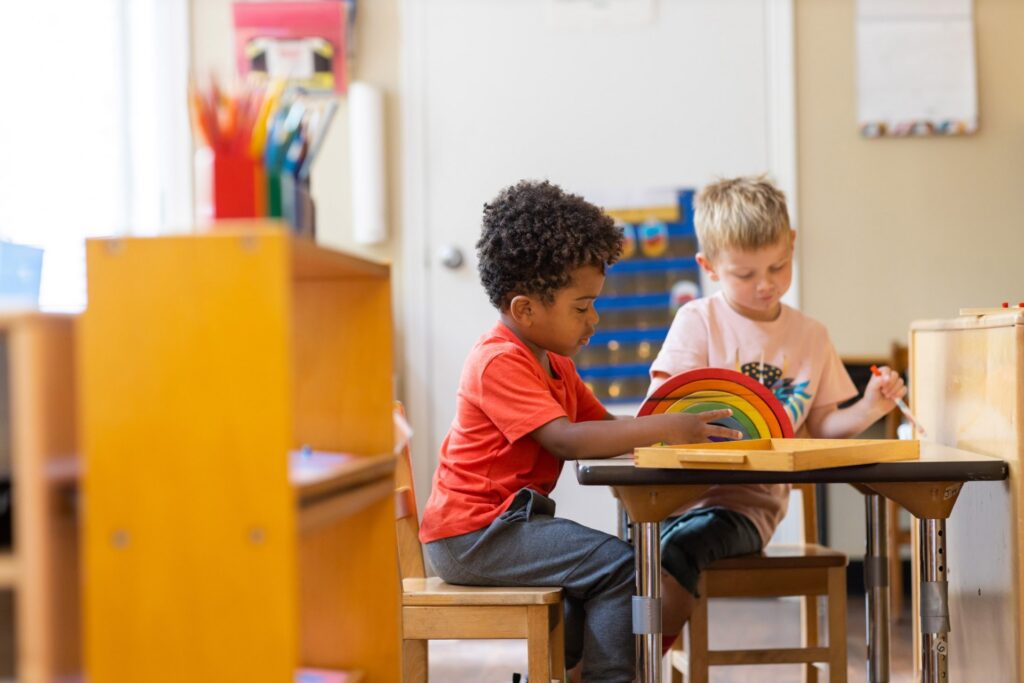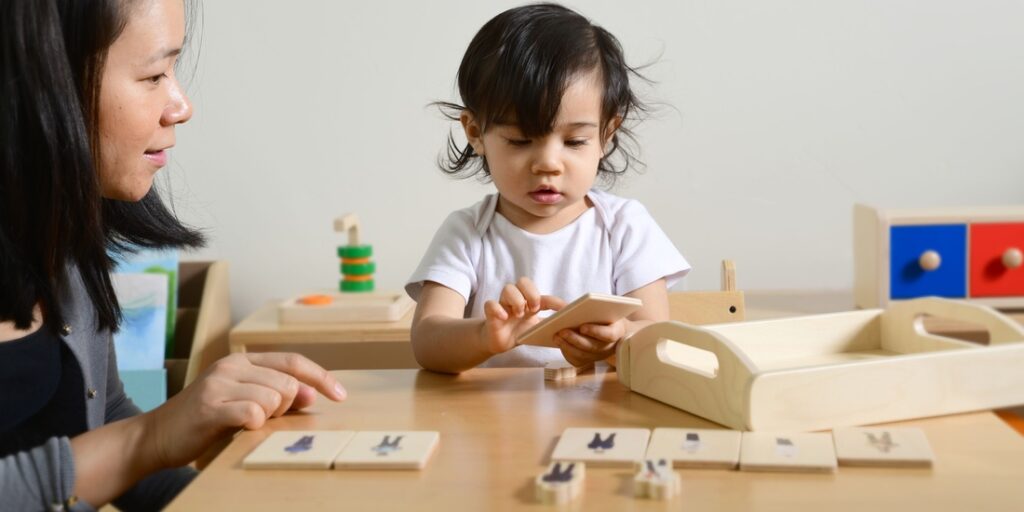Dialogic reading sounds technical, but it’s actually a simple way for grown-ups to actively engage children in books and promote their pre-reading and early language skills.
Here’s how you can incorporate this approach into your reading routine.
What does ‘dialogic reading’ mean?
Dialogic reading is a style of reading which involves your child taking the lead and becoming the storyteller. This means that instead of listening to you reading the book, your child is encouraged to be the ‘reader’ (even if they can’t yet read).
As a parent, your role is also reversed. You become an ‘active listener’ – repeating and expanding on what your child says, asking lots of questions, following your child’s interests, providing feedback and generally helping them become the teller of the story. Your job is to make the reading experience fun and encourage your child to engage with the book.

How does dialogic reading work in practice?
Reading Rockets says that the ‘PEER’ sequence is the reading technique to use. This involves you:
- Prompting your child to say something about the book;
- Evaluating your child’s response;
- Expanding your child’s response by rephrasing and adding information to it; and
- Repeating the prompt to ensure your child has learned from the expansion.
So, if you and your child are looking at a book with a picture of a Dalmatian in it, you would say, ‘What is this?’ (the prompt) while pointing at the Dalmatian. When your child says, ‘dog’ you would say, ‘That’s right! (the evaluation), it’s a spotty dog (the expansion). Can you say ‘spotty dog?’’ (the repetition).
After the initial reading, Reading Rockets says that PEER sequences should happen on nearly every page every time you read the book.
At first, you might choose a book your child is already familiar with, or read all the words on the page and prompt your child to say something. Then, as you re-read the book and your child becomes more comfortable, you can read fewer of the written words and give your child more complex prompts.

What sort of prompts can you use?
There are five different types of prompts used in dialogic reading (easily remembered as ‘CROWD’):
- Completion prompts, where you leave a blank at the end of the sentence in a rhyming or repetitive book.
You might say, ‘I think I’d be a glossy cat. A little plump but not too … ’ to encourage your child to say, ‘fat’ and learn about the structure of language.
- Recall prompts, where your child has to remember something that’s happened earlier in the book or in a prior reading.
You might say, ‘Can you tell me what happened to the baby pig in this story?’ to help your child understand the plot and sequence of events.
- Open-ended prompts, which focus on the pictures in beautifully illustrated books.
You might say, ‘Tell me what’s happening in this picture,’ to promote your child’s attention to detail and ‘expressive fluency’.
- Wh- prompts, which normally begin with what, where, when, why and how questions.
You might point at an object and say, ‘What’s the name of this?’ to teach your child new vocabulary.
- Distancing prompts, which ask your child to relate the words or pictures in the book to experiences outside the book.
You might point at a farm animal picture and say, ‘Remember when we went to the petting zoo last week? Which of these animals did we see there?’ to promote your child’s verbal fluency, conversation skills, narrative abilities and help them link books and the real world.

How can you tailor dialogic reading to your child’s age, interests and abilities?
Before you launch into a book together, think about what developmental stage your child is at, what they’re interested in and what type of prompts to use.
Any picture book can be used for dialogic reading, but to keep your child engaged, it helps to choose books:
- That are suited to their age and ability;
- Have rich, detailed pictures;
- Aren’t text heavy; and
- Are predictable and repetitive.
It’s important to choose a book about something your child is interested in or let them choose the book. And when it comes to prompts, keep in mind that distancing prompts and recall prompts are trickier than completion, open-ended and wh- prompts.
As a guide, the experts at Nebraska Extension suggest these kinds of prompts for different ages:
| Age | Recommended prompts | Example |
|---|---|---|
| 6 to 12 months | ‘Where’ questions that your baby can answer by pointing | ‘Where is the dog? Can you touch the dog?’ |
| 1 to 2 years | Prompts that require simple, spoken answers from your child | ‘What does the dog say?’ |
| 2 to 3 years | Simple questions about the story | ‘What did the dog do next?’ |
| 3 to 4 years | Open-ended questions that encourage your child to think and explain | ‘How do you think the dog feels? Why do you think it feels that way?’ |
| 4 to 5 years | Prompts that ask your child to recall something in the story, or relate the story to their own life and experiences | ‘We read this story at Granny’s last week! Do you remember what happened to the cow?’ or ‘The girl is sad she lost her bear. When is a time that you were sad?’ |
As you’re going through the book with your little reader, focus on providing praise, encouragement and fun experiences. You might say, ‘Hippopotamus is a big word! I’m impressed that you can say it so well!’ to encourage them to try other words, or follow their imaginative version of the story without correcting or redirecting them.

Mix up your prompts with straight reading, so the book doesn’t feel like a relentless quiz session, and if your child is getting tired, bored or frustrated, think about how you can restore their interest. For instance, you might:
- Offer to take turns reading;
- Give your child a bit of extra support by prompting with simple questions;
- Try a different book; or
- Finish the book early.
What are the benefits of dialogic reading?
The experts say that children learn most from books when they’re actively involved, and dialogic reading is a valuable way to:
- Expand your child’s vocabulary with new words;
- Promote their speaking skills;
- Build their confidence and sense of accomplishment;
- Encourage positive associations with reading;
- Help your child focus if they find it hard to sit down and listen to a book; and
- Develop your child’s important pre-reading skills. These are the skills that will help them prepare for reading, and include things like learning how to hold a book, name different letters and identify rhyming words.
For parents, dialogic reading provides a chance to be an active listener, tap into your child’s interests and abilities, and have fun together. With a bit of practice, this reading approach is a chance to connect as parent and child, and help your little learner understand new words, worlds and ways of thinking.


